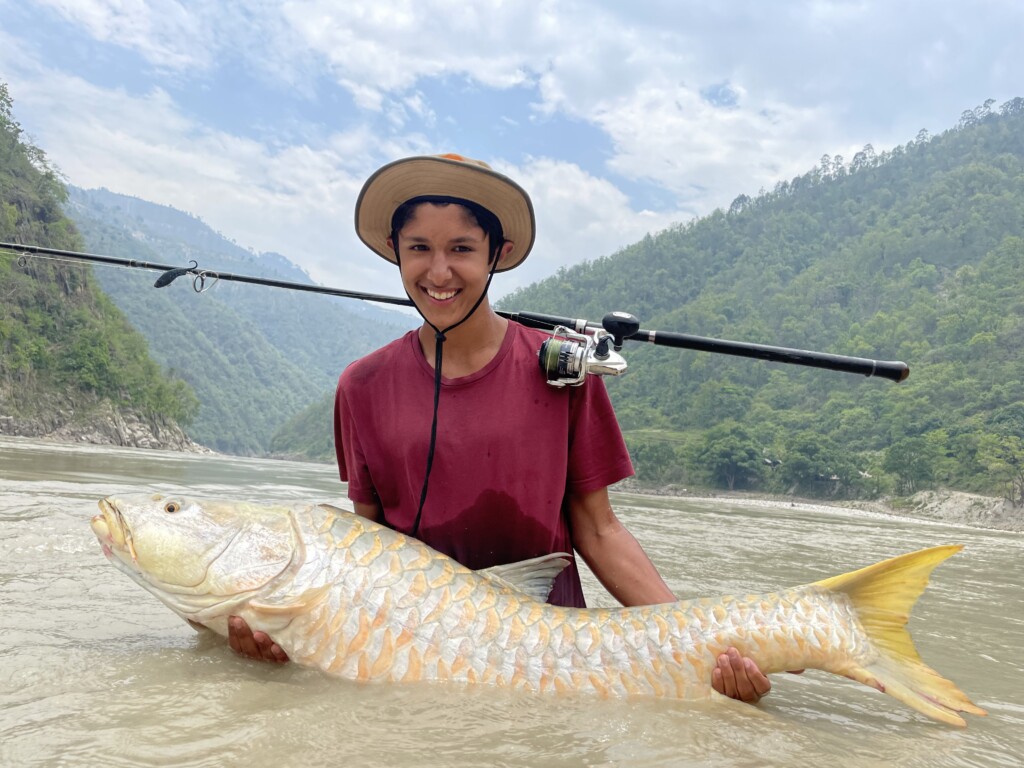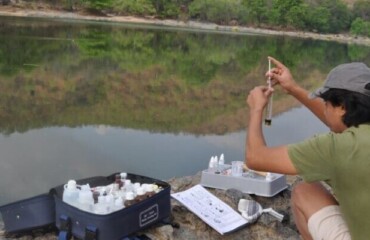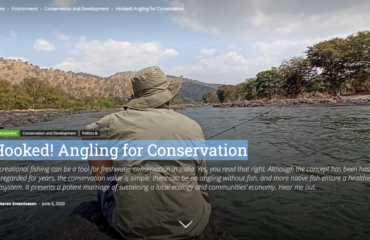The Everlasting Pursuit of the Mighty Mahseer. By Haider Ashraf.

I stalk from rock to rock, pool to pool. Attempting to move slower with every step. I fear the Mahseer gliding out of the bottomless kund, envisioning its aquatic habitat. As I delicately roll my leg from one gravel bed onto another, unknowingly of its certainty. I feel a wobbling sensation as a rock plunges in the water. With disappointment lingering and an urge to quit, I watch as the elusive Mahseer slips away. Unfettered, I cast my line once more into the flowing waters of the Kali River, leaving the past behind. I sensed the joy of a flawless cast dropping into the water with a sound of void, a feeling like a first, knowing that the Mahseer might bite or never. Still, the lure is taking motion, reeling slower and slower, staring through the water and into the eyes of the Rapala, I gently lower the rod tip.
Just then, the Mighty Mahseer bites and runs like lightning in a quarter of a blinking gaze. A feeling I look for every day. Sweating it out in the quiet jungle, with the serene sounds of silence. Before I know it, the splendid creature has reached the mighty rapids and is headed south. I know the fight will bring it in, with my veins on the verge of erupting out of my arms due to the Mahseer pulling hard with all its mighty 60 pounds. I ask for forgiveness, but the angler within me, knows what he must do for the Mahseer. He flows with the nippy glacier-melted kali, getting closer and closer to the rapids, fearing losing the line. I dont feel the substantial pressure anymore, I know what’s occurred. The Mahseer is gone, for good. Oh, Haider “Far and wide are my borders, Stern as death is my sway. I wait for the men who will win me; But I won’t be win in a day
I won’t be won by weaklings, subtle suave and mild; But by men with the hearts of Vikings and the simple faith of the child. Desperate strong and relentless, unfettered by fear of defeat.
Them will I gild with my treasure
Them will I glut with my meat” (Service.).
I will return the next day, searching for the same feeling which never ends. I am trapped in the pursuit of the Mahseer, which lures me.
The Mahseer, a threatened group of cyprinid fishes (Pinder & Raghavan), holds immense importance in India as an indicator of healthy aquatic ecosystems, especially in the highly eco-sensitive sub-mountain Himalayan regions. Involving local hill communities in tourism-related mahseer conservation will catalyze a virtuous cycle leading to sustainable development efforts. Conserving the Mahseer population is crucial for preserving the ecological integrity of aquatic habitats and highlights the values local communities bring to the country. Creating a self-feeding virtuous cycle.
Why is it important?
Importance of aquatic habitats
The golden fins with their slimy residue all over your hands, feel like no other. Satisfaction comes from persistence. You have now earned the right to retain the spectacular creature. Just for a minute, I am an Angler. I see my future in its shimmering scales. However, The essence of the golden Mahseer lies beneath its beauty. The Mahseer serves as a compelling testament to the state of aquatic well-being in freshwater regions of India.
The presence of a Mahseer signifies a healthy marine environment which is one of the most essential parts of the world today. Water is at the core of sustainable development and a driving force for socio-economic development. Without water, the food production system and healthy ecosystems will fail, eventually leading to a decline in human survival. Everything in the world involves the necessity of water, whether it is a stool coming from plastic or a wooden table from sal trees. The cruciality of water is made clear through the establishment of the world. Any decline in its numbers is an alarm bell, signaling potential threats such as habitat degradation, pollution, or overexploitation. By monitoring the health and abundance of the Golden Mahseer, conservationists gain valuable insights into the overall well-being of aquatic ecosystems, facilitating interventions to preserve these vital habitats. The disturbance in aquatic health plays a significant role in larger issues in the world. If water in the freshwater tributaries turns toxic due to overconsumption and water pollution, the natural water cycle can be affected. When water vapor rises into the atmosphere, it cools down and condenses into tiny water droplets, forming clouds. As the water droplets in the clouds combine and become heavy enough, they fall to the Earth’s surface as precipitation. In colder regions, it snows to form glaciers, which melt into rivers creating a glacier-fed river that is considered the home of the golden Mahseer.
In the condensing process, the water vapor can be infected with contaminated air, which could promote more significant global issues such as global warming and air pollution. As well as a healthy marine domain, the Mahseer signifies an ecological balance. Due to the Mahseer’s extinction, the prey fish have increased disproportionately, which has caused the algae in the water to start disappearing. This is frightening, as algae are the basis of most aquatic food webs. They help to purify the water by absorbing nutrients and heavy metals from rivers, which promotes a healthy riverine ecosystem.
Tourism
Being a Mahseer in the world of a failing society helps showcase the depth of uncertainty not only with the rivers of India but also the uncertain future of communities that aren’t exposed to the public eye. These communities flourish with their untouched aspect of living which was the same 50 years back, and can bring an unknown perspective of life to people like us who have been trapped in the lives of social media and chaos. Speaking of being untouched, not only in the aspect of thought but beauty. Many of these locations have been promoted because of their spectacular mahseer fishing, but they also have their own charm which pulls us even further into it . Many sites were popular during the time of the British Raj. They were the ones who introduced Mahseer fishing to the rest of us. They started the craze for it and now we are affected by it. In those days, fishing was usually done in the Kauvery, which flows through multiple states, such as Karnataka, Kerala, Tamil Nadu, and the union territory of Puducherry.
The Ganges was a famous spot for Angling. Foreigners worldwide had come to fish for the Big Mahseer. When India gained its independence, The Britishers went back home. The rage for Mahseer fishing was gone. The stoppage of Mahseer fishing affected the enrichment and importance given to the communities. Many places that hadn’t been heard of before, were given significance because of the Mighty Mahseer. It was as if the respect was taken away from them and they were back to being remote areas that nobody had known and respected. The care given to the fish was co-related to the respect given to the communities.
Many inspired youngsters were enthralled by the aspect of landing the Mahseer, which was a start to their devotion to conserving the Mahseer. Individuals such as Misty Dhillon were the ones who brought Mahseer back to life and became the face of angling in India. Many such places in India are now given recognition. The sport of Angling has gained popularity amongst people from all generations. With fishing, people are able to see a new side of India which they would otherwise never have.
Hindu Mythology
The significance of the Mahseer in Indian culture and mythology spans back centuries to the Vedic period (1750–500 BC) and holds a special place in Hindu beliefs. This majestic fish thrives in the sub-mountain Himalayan rivers, making it an integral part of the ecosystem and local traditions. In numerous Hindu legends and mythological tales, the Mahseer carries deep symbolic meaning, often associated with prosperity and divine connections. After understanding its cultural significance, our rural population has gained curiosity and interest in the ways of the Mahseer. They were astonished by more than just the magnificence, looks and immense size of Tor Puttitora. As they gained interest in the ways of the Mahseer, they gave the fish significance and protection. This helped raise interest among Indians, which was a turning point in conserving the Mahseer, leading to many Indians becoming aware and raising awareness towards the fish and how it has helped the society. The strong motive behind their action has been woven into the sport of angling, which has constantly been enriched by culture. The fundamentals of angling revolve around respect. Showing respect to the Mahseer before you hook it is easy, but a true angler will show the same gratitude he showed when he has caught it and while releasing it. This is why species like the golden Mahseer survive and thrive through the Indian ravines.
What has happened to the Mahseer?
Poaching
The Mahseer which we know of, the monster of the river, the fish like no other, the Mahseer is unique to the freshwater rivers in India. Miscreants who stay close to these rivers have found a way to ‘fish’ the Mahseer using a primitive but effective method that is being misused and has led to the Mahseer being killed in 100s by human made bombs—a process known as dynamiting, where fishermen drop country-made bombs into the water. Whole shoals of dead fish rise to the surface, are gathered, and sold to the local market at a high price. This despicable business is a leading cause for the drop in the Mahseer population. Many fishing spots in the country have still been cared for by local activists due to the known significance of the fish, showcased by its place in Hindu mythology. However, many still put money above priceless creatures, which isnt their fault. It is simply due to villagers’ ignorance of aquatic wellbeing, a big reason for the harmful water quality, resulting in poor marine life. The exact numbers are not known, but a 2010 report referred to by the IUCN notes that the golden Mahseer is estimated to have declined by more than 50 percent in recent years, “and if the current trends continue and with the new dams being built, the population may decline even up to 80 percent in the future” leading to the verge of extinction. The number of remote areas on ravine banks has caused this miraculous decline. With fewer routine checking, there is no fear of the authorities restricting the poachers, making dynamiting a much more convenient way to make money while putting humanity behind them.
Construction of Dams
Through decades in India, there have been conversations about possible dams being built. Dams are structured and constructed across a stream or river to hold water back. We can use dams to store water, control flooding, and generate electricity. Dams are essential but it inevitably relates to aquatic health being compromised by such steps. I was recently in the beautiful locality of Pancheshwar, a remote village on the Indo-Nepal border. This well-known mecca of Mahseer fishing has been open to passionate anglers like me for decades. But as I was there this summer, I heard that there were discussions of a dam being built just downstream of the Kali. Not just in Pancheshwar but many of the few clean freshwater rivers with beautiful aquatic habitats are being shackled by dams just for the sake of better electricity in cities, which is destroying our unique Marine ecosystems which shelter the Mahseer. They signify a healthy world outside of their own, with the way the Mahseer flees the rivers right as the water turns contaminated with toxins, which showcases the concern with glaciers from which the water is coming down. Inevitably signaling that the air is tainted, leading to more significant issues such as global warming, pollution, and other dangerous problems. Getting more people involved into raising awareness for the aquatic life in our pristine rivers can eventually turn into a self-feeding virtuous cycle. Construction of Dams inevitably diminishes the process.
In conclusion, pursuing the elusive Mahseer reveals a deep connection between humankind and the natural world. As we venture into the quiet jungles and secluded riverbanks, we become part of the ecosystem and its delicate balance. The Mahseer’s majestic beauty serves as a living testament to the health of our freshwater regions. We can catalyze sustainable development and safeguard the Mahseer’s future by involving local communities in conservation efforts. Let us unite in our commitment to protect these marvelous creatures, preserve biodiversity, and reaffirm our role as stewards of the planet. Together, we can ensure the legacy of the Mighty Mahseer for generations to come.




